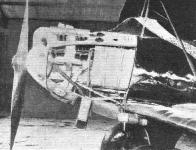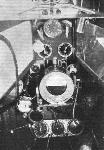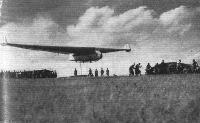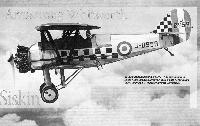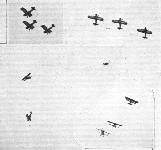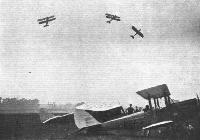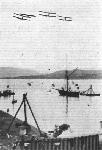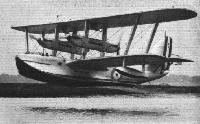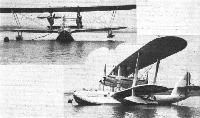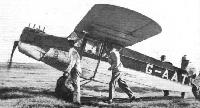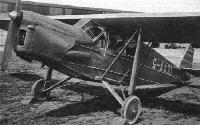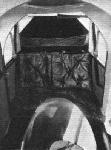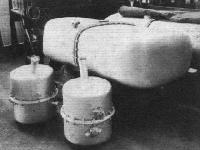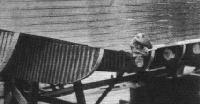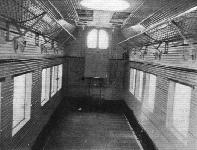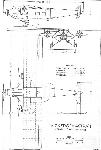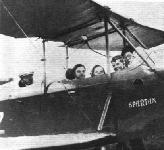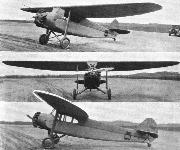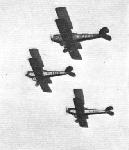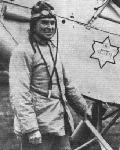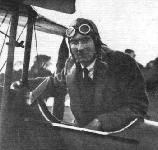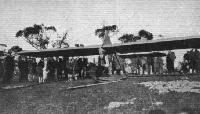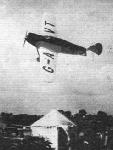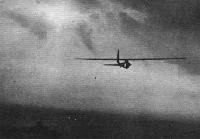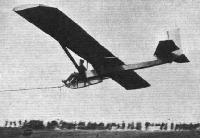Фотографии
-
The collapsible lifeboat carried on the "Question Mark.''
Самолёты на фотографии: Breguet Br.19GR Grand Raid / Br.19TF Super Bidon - Франция - 1925
-
The Breguet "Grand Raid" sesquiplan, "Question Mark," flown by Gostes and Bellonte.
Самолёты на фотографии: Breguet Br.19GR Grand Raid / Br.19TF Super Bidon - Франция - 1925
-
The 650-h.p. Hispano-Suiza engine in the "Question Mark." The small petrol tanks under the wings, of 44 gals, each, were removed before starting on the Transatlantic flight.
Самолёты на фотографии: Breguet Br.19GR Grand Raid / Br.19TF Super Bidon - Франция - 1925
-
The retractable wireless generator, which was withdrawn into the fuselage when not in use.
Самолёты на фотографии: Breguet Br.19GR Grand Raid / Br.19TF Super Bidon - Франция - 1925
-
The pilot's cockpit of the "Question Mark."
Самолёты на фотографии: Breguet Br.19GR Grand Raid / Br.19TF Super Bidon - Франция - 1925
-
A model of an S.E.5 which was used to advertise the R.A.F. Halton Tattoo held at Halton last Thursday and which will be repeated on Saturday.
Самолёты на фотографии: RAF S.E.5 - Великобритания - 1916
-
Another view of the tail-less machine before the engine has been put in. This machine was only built after exhaustive tests with models, and has an estimated top speed of 110 m.p.h. The wing-tip fins and rudders are of a thick aerofoil section and also act as skids. The pilot's view seems to be negligible.
Самолёты на фотографии: Lippisch Delta I - Германия - 1930
-
The tailless machine of the R.R.G. being tried out as a glider.
Самолёты на фотографии: Lippisch Delta I - Германия - 1930
-
Регистрационный номер: J8959 [2] 43-я эскадрилья была в числе 11 подразделений, летавших на Siskin. Этот J-8959 и еще 73 машины были построены "Gloster Aircraft Company".
In spite of its uncowled engine, fixed undercarriage, open cockpit and externally braced wings, the Armstrong Whitworth Siskin was regarded in its day (introduced in 1924) as a high performance fighter. This particular aircraft (J-8959) is a Siskin IIIA of 43 Squadron. It displays an unusual wing arrangement in that the top wing had three times the area of the lower wing.Самолёты на фотографии: Armstrong Whitworth Siskin - Великобритания - 1921
-
The Siskins of No. 43 F.S. in Flights Astern, stepped up.
Самолёты на фотографии: Armstrong Whitworth Siskin - Великобритания - 1921
-
The unique picture above shows No. 43 F.S. in Flights Astern with the wings looped together.
Самолёты на фотографии: Armstrong Whitworth Siskin - Великобритания - 1921
-
Регистрационный номер: J8959 [2] 43 Sqn Siskin IIIAs up from RAF Tangmere in August 1930 flying in echelon starboard, stepped up. Leading the formation in Siskin J8959 is the squadrons CO, Sqn Ldr C.N. Lowe.
Самолёты на фотографии: Armstrong Whitworth Siskin - Великобритания - 1921
-
No. 43 (Fighter) Squadron, above in the "tied-together" formation, and below doing the Prince of Wales' Feathers and looping in line astern.
Самолёты на фотографии: Armstrong Whitworth Siskin - Великобритания - 1921
-
Регистрационный номер: G-ABAS, G-ABBH BEDFORD: The line up of demonstration machines, showing Metal Moth (Gipsy I), Puss Moth (Gipsy III). Desoutter II (Gipsy III), Moth (Cirrus III), Avian (Hermes), Autogiro (Genet Major).
Самолёты на фотографии: Avro Avian / Type 594/616 - Великобритания - 1926Cierva/Avro C.19 - Великобритания - 1929De Havilland Gipsy Moth / Moth X - Великобритания - 1928De Havilland Puss Moth / D.H.80 - Великобритания - 1929Koolhoven FK-41 - Нидерланды - 1928
-
Регистрационный номер: G-ABCJ A VISITOR TO THE LEICESTER MEETING: The Saunders-Roe "Cloud" (described in our issue of July 25) in its amphibian form, is a very comfortable six-passenger machine, fitted with two Wright "Whirlwind" engines. The machine is quite exceptionally easy to fly, and, in fact, all but flies itself.
Самолёты на фотографии: Saunders-Roe Cloud / A.19 - Великобритания - 1930
-
Miss Vivien Spooner, Miss Winifred Spooner, Sir Sefton Brancker, Miss Amy Johnson, Flt.-Lt. S. D. Scott and Mr. John Lord, all evidently satisfied after their flight in the Saro Cloud (2 Whirlwinds J6-nine)
Самолёты на фотографии: Saunders-Roe Cloud / A.19 - Великобритания - 1930
-
Регистрационный номер: G-AAWW Mr. Runciman (second of the Grosvenor Cup)
Самолёты на фотографии: Klemm L.25 - L.28 Swallow - Германия - 1927
-
The Northampton Club finishing their demonstration of formation flying with a neatly executed "Prince of Wales Feathers." In the foreground are two of the latest D.H. demonstration machines, a Puss-Moth and a metal Moth.
Самолёты на фотографии: De Havilland Gipsy Moth / Moth X - Великобритания - 1928De Havilland Puss Moth / D.H.80 - Великобритания - 1929
-
CANNES: A formation of Moths, flown by Capt. de Havilland (Puss Moth) Major Cordes, Comte de Beauregard, Mr. Edouard Bret giving a display along the sea front by the Palm Beach Casino. Mr. Bret is the son of the owner of the Hotel des Anglais, who is always ready to welcome English private owners and arrange aerodrome accommodation.
Самолёты на фотографии: De Havilland Gipsy Moth / Moth X - Великобритания - 1928De Havilland Puss Moth / D.H.80 - Великобритания - 1929
-
Регистрационный номер: G-ABDW ON HINKLER'S TRACK: Capt. F. R. Matthews, until recently Chief Instructor at the London Aeroplane Club, started from Croydon on September 16 on an attempt to reach Australia in a shorter time than the 15 1/2 days taken by Hinkler in 1928. He is flying a de Havilland "Puss Moth" with Gipsy III engine. Extra tanks have been installed in the cabin, bringing the total petrol capacity up to 100 gallons. This should give the machine a still-air range of approximately 2,000 miles. Capt. Matthews left Croydon at 6.30 a.m. and landed at Belgrade at 4.15 p.m., having averaged 115 m.p.h.
Самолёты на фотографии: De Havilland Puss Moth / D.H.80 - Великобритания - 1929
-
ON HINKLER'S TRACK: Capt. F. R. Matthews, until recently Chief Instructor at the London Aeroplane Club, started from Croydon on September 16 on an attempt to reach Australia in a shorter time than the 15 1/2 days taken by Hinkler in 1928. He is flying a de Havilland "Puss Moth" with Gipsy III engine. Extra tanks have been installed in the cabin, bringing the total petrol capacity up to 100 gallons. This should give the machine a still-air range of approximately 2,000 miles. Capt. Matthews left Croydon at 6.30 a.m. and landed at Belgrade at 4.15 p.m., having averaged 115 m.p.h.
Самолёты на фотографии: De Havilland Puss Moth / D.H.80 - Великобритания - 1929
-
Самолёты на фотографии: Short Singapore I / S.5 - Великобритания - 1926
-
THE "SINGAPORE" MARK II: Two views of the machine at rest. Note the small frontal area, and the lower wing root fairings.
Самолёты на фотографии: Short Singapore I / S.5 - Великобритания - 1926
-
Самолёты на фотографии: Blackburn Bluebird / L.1 - Великобритания - 1924
-
Регистрационный номер: N241 [2] Самолёты на фотографии: Blackburn Sydney / R.B.2 - Великобритания - 1930
-
Регистрационный номер: N241 [2] THE BLACKBURN "SYDNEY": This machine is generally similar to, but a Service version of the "Nile," the hull of which was exhibited at Olympia last year.
Самолёты на фотографии: Blackburn Sydney / R.B.2 - Великобритания - 1930
-
A PREVIOUS AUSTRALIAN FLIGHT: This illustration may be of interest just now, for it shows the first cabin monoplane to make a flight from England to Australia - the Desoutter ("Cirrus-Hermes") of Flying Officers Piper and Kay, taken on their arrival at Mascot Aerodrome on April 3 last.
Самолёты на фотографии: Koolhoven FK-41 - Нидерланды - 1928
-
Регистрационный номер: G-AAZI [4] VIEW: This illustration of the nose of the Desoutter Mark II, indicates the excellent view obtained by the pilot in the latest model. The engine is a Gipsy III.
Самолёты на фотографии: Koolhoven FK-41 - Нидерланды - 1928
-
THE NEW TAIL: The photograph shows the tail of the Desoutter Mark II.
Самолёты на фотографии: Koolhoven FK-41 - Нидерланды - 1928
-
Регистрационный номер: G-AAZI [4] THE DESOUTTER MARK II: Three-quarter Front View.
Самолёты на фотографии: Koolhoven FK-41 - Нидерланды - 1928
-
Регистрационный номер: G-AAZI [4] THE DESOUTTER MARK II: Side view.
Самолёты на фотографии: Koolhoven FK-41 - Нидерланды - 1928
-
Регистрационный номер: G-AAZI [4] THE DESOUTTER, MARK II: Three-quarter rear view.
Самолёты на фотографии: Koolhoven FK-41 - Нидерланды - 1928
-
A VERY COMFORTABLE CABIN: The latest Desoutter, Mark II, has been designed with a view to giving real comfort to the occupants. The pilot's cockpit is roomy and the windows and large windscreen give an excellent view in all essential directions.
Самолёты на фотографии: Koolhoven FK-41 - Нидерланды - 1928
-
The slightly staggered seats for two passengers are well placed to avoid fatigue, and air cushions help to make a flight of even very long duration less tiring than a train journey.
Самолёты на фотографии: Koolhoven FK-41 - Нидерланды - 1928
-
THE DESOUTTER MARK II: On the left the very simple engine mounting, of welded steel tube, and on the right details of the manner in which the wing is located on the fuselage.
Самолёты на фотографии: Koolhoven FK-41 - Нидерланды - 1928
-
The ailerons are operated from the joy stick by a vertical tube and a crank on the spar. The crank, and its inspection door, is shown on the left. On the right, details of lift strut attachment to spar.
Самолёты на фотографии: Koolhoven FK-41 - Нидерланды - 1928
-
THE NEW TAIL: On left, the tail incidence adjustment, and, on the right, the bent crank which operates the elevator.
Самолёты на фотографии: Koolhoven FK-41 - Нидерланды - 1928
-
Desoutter Mk.II Gipsy III Engine
Самолёты на фотографии: Koolhoven FK-41 - Нидерланды - 1928
-
Регистрационный номер: G-AAWZ THE SPARTAN "ARROW": This is the new version of the Spartan and was first shown in public in the King's Cup Race. Particular attention has been paid to the view from both cockpits.
Самолёты на фотографии: Spartan Arrow - Великобритания - 1930
-
A MILLIONAIRE'S CHOICE: Mr. Marshall Field's Loening amphibian in which he and his bride (formerly Mrs. Dudley Coats) are making a honeymoon tour.
Самолёты на фотографии: Loening Air Yacht - США - 1928
-
Регистрационный номер: S1229 Самолёты на фотографии: Supermarine Southampton / Solent - Великобритания - 1925
-
Регистрационный номер: S1249 [2] Самолёты на фотографии: Supermarine Southampton / Solent - Великобритания - 1925
-
THE R.A.F. BALTIC CRUISE: The four Supermarine "Southamptons" of No. 201 Squadron at Stockholm.
Самолёты на фотографии: Supermarine Southampton / Solent - Великобритания - 1925
-
Регистрационный номер: S1249 [2] Самолёты на фотографии: Supermarine Southampton / Solent - Великобритания - 1925
-
Регистрационный номер: G-AAUB [3] THE VICKERS LYNX "VIASTRA I": In the three-quarter front view, the Townend rings around the engines may be clearly seen.
Самолёты на фотографии: Vickers Viastra / Type 160 - Великобритания - 1930
-
NEARING COMPLETION: In this photograph, taken before the machine was finished, may be seen the central engine (Lynx), forward luggage compartment, and windscreening of cockpit.
Самолёты на фотографии: Vickers Viastra / Type 160 - Великобритания - 1930
-
FOR THE FRISE AILERONS: Photograph showing brackets on which the ailerons are supported.
Самолёты на фотографии: Vickers Viastra / Type 160 - Великобритания - 1930
-
A NEW STYLE IN PETROL TANKS: In the "Viastra" Vickers use fuel tanks built up in two identical halves, joined in the centre by a flange coupling of novel design.
Самолёты на фотографии: Vickers Viastra / Type 160 - Великобритания - 1930
-
FUSELAGE DETAILS: This photograph shows the construction and placing of the formers which carry the cabin flooring. The fitting on the side is the anchorage for the radius rod of the undercarriage.
Самолёты на фотографии: Vickers Viastra / Type 160 - Великобритания - 1930
-
Регистрационный номер: G-AAUB [3] THE VICKERS LYNX " VIASTRA I": Side view.
Самолёты на фотографии: Vickers Viastra / Type 160 - Великобритания - 1930
-
FUSELAGE DETAILS OF THE "VIASTRA I": On the left, the junction of rear to cabin portion before completely covered. In the centre view the false floor of the goods compartment is shown raised up, while on the right it is shown in place. This floor enables very heavy concentrated loads to be supported.
Самолёты на фотографии: Vickers Viastra / Type 160 - Великобритания - 1930
-
Регистрационный номер: G-AAUB [3] THE VICKERS LYNX "VIASTRA I": Three-quarter rear view.
Rear view of the Viastra I. Note the different angles of the horizontal tail surfaces and the wrongly painted registration. The aircraft first flew on October 1, 1930.Самолёты на фотографии: Vickers Viastra / Type 160 - Великобритания - 1930
-
THE CABIN: The photograph shows the finished cabin, before the seats are installed
Самолёты на фотографии: Vickers Viastra / Type 160 - Великобритания - 1930
-
THE CABIN: The photograph shows the cabin during construction.
Самолёты на фотографии: Vickers Viastra / Type 160 - Великобритания - 1930
-
THE "VIASTRA" CABIN, LOOKING AFT: Note the roof lights. The door leads to the lavatory and exit
Самолёты на фотографии: Vickers Viastra / Type 160 - Великобритания - 1930
-
The lavatory
Самолёты на фотографии: Vickers Viastra / Type 160 - Великобритания - 1930
-
THE CABIN: The sketches show details such as ventilators, etc. Small sand bags riveted to the metal covering are intended to prevent "drumming."
Самолёты на фотографии: Vickers Viastra / Type 160 - Великобритания - 1930
-
ON THE "VIASTRA": On the left the fitting to which the bent axle and main wing bracing strut are attached. On the right the fitting on the upper longeron to which is attached the diagonal strut of the wing bracing.
Самолёты на фотографии: Vickers Viastra / Type 160 - Великобритания - 1930
-
SOME "VIASTRA" DETAILS: On the left is shown the construction of wing spars and ribs, while on the right is a sketch of the unusual arrangement of the rudders.
Самолёты на фотографии: Vickers Viastra / Type 160 - Великобритания - 1930
-
Vickers "Viastra" I 3 Geared "Lynx" Engines
Самолёты на фотографии: Vickers Viastra / Type 160 - Великобритания - 1930
-
FULL MEASURE: Col. Strange with an enthusiastic load in his 3-seater Spartan.
Самолёты на фотографии: Simmonds Spartan - Великобритания - 1928
-
AN AMERICAN ALL-METAL MONOPLANE: The Thaden T-4, constructed by the Pittsburgh Metal Airplane Co., is a four-place cabin monoplane fitted with a 300-h.p. Wright J-6 engine. The monocoque fuselage is built up of duralumin tubing covered with corrugated alclad, and the multi-spar (alclad plate) wings, also with corrugated covering, employ the new Clark "S" design. This machine has a speed range of 57-138 m.p.h., a climb (sea level) of 1,000 ft./min., a service ceiling of 15,000 ft., and a cruising range (112 m.p.h.) of 550 miles. The span is 45 ft., and the overall length 31 ft. 9 in. The weights are: empty, 2,250 lb. ; loaded, 3,720 lb.; wing loading, 13-58 lb./sq. ft.; power loading, 12 4 lb./h.p.
Самолёты на фотографии: Thaden T-2 / T-4 - США - 1928
-
The Leicestershire Club in formation.
Самолёты на фотографии: De Havilland Gipsy Moth / Moth X - Великобритания - 1928
-
Mr. Griffith Brewer in front of his new Moth (Gipsy I).
Самолёты на фотографии: De Havilland Gipsy Moth / Moth X - Великобритания - 1928
-
Mr. Turnbull, the winner of the Grosvenor Cup
Самолёты на фотографии: De Havilland Gipsy Moth / Moth X - Великобритания - 1928
-
Регистрационный номер: G-ABBY A NEW AVRO V: In this new version of the "Five," the outboard engines have been raised and faired into the wing. The height of the cabin has been increased by about one foot. The cabin has seating accommodation for four passengers, and behind the cabin is a lavatory. The engines are Armstrong-Siddeley "Genet Majors."
Самолёты на фотографии: Avro Five / Type 619 / Six / Type 624 - Великобритания - 1929
-
Flt.-Lt. Crawford on the left in a Kent Club Zogling, and Mr. Derham on the right in a Channel Club Zogling, at a meeting held by the former club last week-end.
Самолёты на фотографии: Lippisch / RRG Zogling - Германия - 1926
-
Mr. A. H. Wilkins, the club instructor to the South Australia Gliding Club at Adelaide, South Australia, in a club glider at O'Halloran Hill. As in England many clubs have recently been formed in Australia.
Самолёты на фотографии: Lippisch / RRG Zogling - Германия - 1926
-
Регистрационный номер: X855E UNORTHODOXY: This Bellanca Sesquiplane, designed and built for the Chicago Daily News, is believed to be intended for an attack on the long-distance record. Note that the engines, Curtiss "Conquerors," are placed in tandem, one as a tractor and one as a pusher. The machine has a span of 83 ft. 2 in., a wing area of 912 sq. ft., a tare weight of 8,000 lb., and a load of approximately the equivalent of its own weight. With a gross weight of 15,500 lb., the top speed claimed is 160 m.p.h., and the cruising speed 132 m.p.h. The machine has been flown at this weight on either of the two engines, the speed with front engine being 116 m.p.h., and with rear engine running, 114 m.p.h.
Самолёты на фотографии: Bellanca TES - США - 1929
-
Регистрационный номер: G-AAVT Capt. Percival (third on the Grosvenor Cup) on his left
Самолёты на фотографии: Hendy Hendy 302 - Великобритания - 1929
-
The Austria. A new 103-ft. span cantilever glider which has been built for Herr Kronfeld. The wings are completely plywood covered, and the rudders can fold inwards together for use as air brakes.
Самолёты на фотографии: Kupper Austria - Австрия - 1930
-
The unorthodox tail unit of Austria. The new glider which has been built for Herr Kronfeld to create a few more records on.
Самолёты на фотографии: Kupper Austria - Австрия - 1930
-
The Luftikus. A successful soaring glider at the Wasserkuppe.
Самолёты на фотографии: BSV Luftikus - Германия - 1929
-
The latest Lowe-Wylde training glider, which has been designed to replace the usual Zogling type. This glider has a form of fuselage which is ply-wood covered. The wings are strutted with spruce struts covered in ply, as is the leading edge of the wing.
Самолёты на фотографии: Lowe-Wylde Columbus / BAC.II - BAC.IX - Великобритания - 1930
-
Herr Kronfeld, who is expected to be the winner of main competitions this year.
Самолёты на фотографии: Lippisch / RRG Wien - Германия - 1929
Статьи
- Flight


